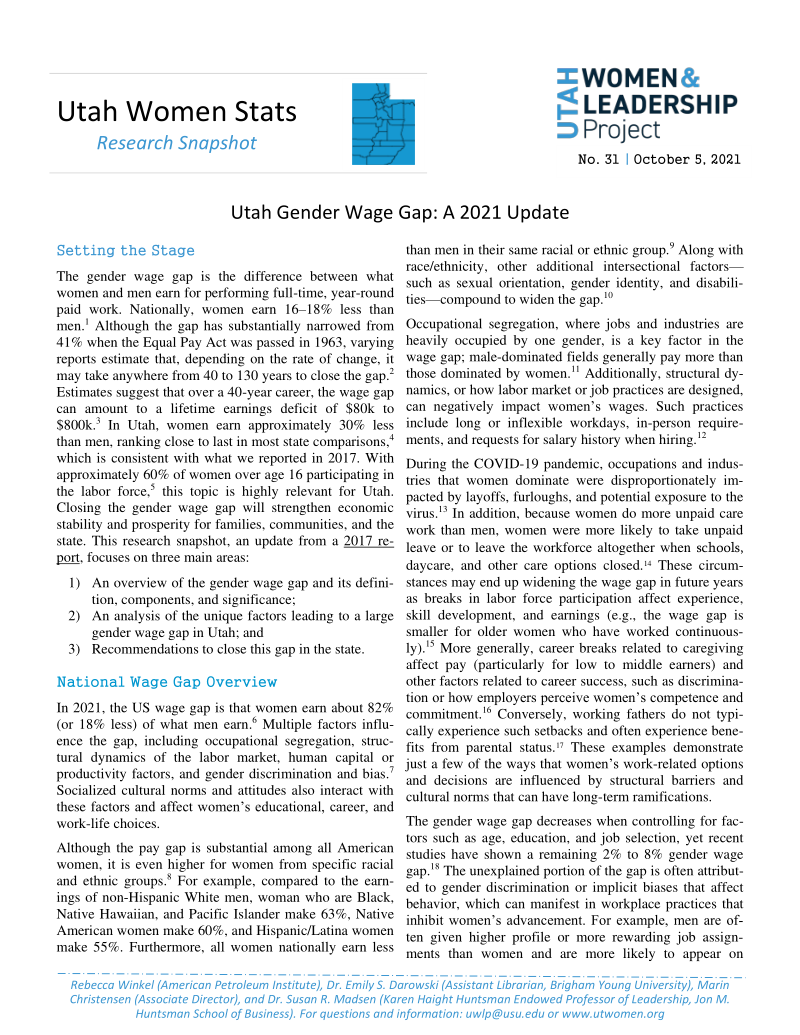USU report reviews gender wage gap literature; finds that "Utah has one of the largest gender wage gaps in the nation."
- Type
- Academic / Technical Report
- Source
- Rebecca Winkel Non-LDS
- Hearsay
- Direct
- Reference
Rebecca Winkel, Emily S. Darowski, Marin Christensen, Susan R. Madsen, "Utah Gender Wage Gap: A 2021 Update," Utah Women Stats Research Snapshot, No. 31, Utah Women & Leadership Project, Utah State University, October 5, 2021, accessed January 24, 2022
- Scribe/Publisher
- Utah Women & Leadership Project
- People
- Rebecca Winkel, Susan R. Madsen, Marin Christensen, Emily S. Darowski
- Audience
- Reading Public
- Transcription
In 2021, the US wage gap is that women earn about 82% (or 18% less) of what men earn. Multiple factors influence the gap, including occupational segregation, structural dynamics of the labor market, human capital or productivity factors, and gender discrimination and bias. Socialized cultural norms and attitudes also interact with these factors and affect women’s educational, career, and work-life choices.
. . . .The gender wage gap decreases when controlling for factors such as age, education, and job selection, yet recent studies have shown a remaining 2% to 8% gender wage gap. The unexplained portion of the gap is often attributed to gender discrimination or implicit biases that affect behavior, which can manifest in workplace practices that inhibit women’s advancement.
. . . . In sum, research confirms that women’s education and labor force decisions contribute to the wage gap, along with occupational segregation and structural dynamics of the labor market. In addition, cultural and gender socialization, along with bias, add another layer of impact. All these factors influence how both men and women evaluate women’s work, their roles in the labor force, and the reward for that work; ultimately, it suggests that what may appear to be decisions of preference by women are often implicitly constrained choices.
. . . . Utah has one of the largest gender wage gaps in the nation: women earn about 70% (or 30% less) of what men earn, which is consistent with what we reported in 2017 (70–71%). . . .Factors that impact the national wage gap also affect Utah. For example, occupational segregation in Utah is prevalent. Many Utah women work in lower-paying sectors (e.g., health services and office support) with little career advancement and are more likely than women nationally to work part time and therefore have fewer benefits. Utah women have also moved more slowly into historically male-dominated, higher-paying occupations. Although recent data show that Utah women earn slightly more bachelor’s degrees than men, they are less likely to earn graduate or professional degrees that lead to higher pay.
Aforementioned family factors may contribute to a higher wage gap in Utah (e.g., via breaks in labor force participation) as the state has one of the nation’s highest marriage rates, the earliest age for marriage, the fourth-highest fertility rate, and the largest average household. Utah is also in the top third of most religious states; approximately 60% of adults belong to the Church of Jesus Christ of Latter-day Saints, which emphasizes marriage and family. Mothers generally participate less in the labor force than fathers, and in Utah, mothers participate even less during child-rearing years. Utah women also take on a larger share than men of unpaid work (e.g., care work and household management). While Utah fares comparatively well in childcare affordability to other states, it is still unaffordable for most families—especially families with more than one child.
- Citations in Mormonr Qnas
The B. H. Roberts Foundation is not owned by, operated by, or affiliated with the Church of Jesus Christ of Latter-day Saints.

